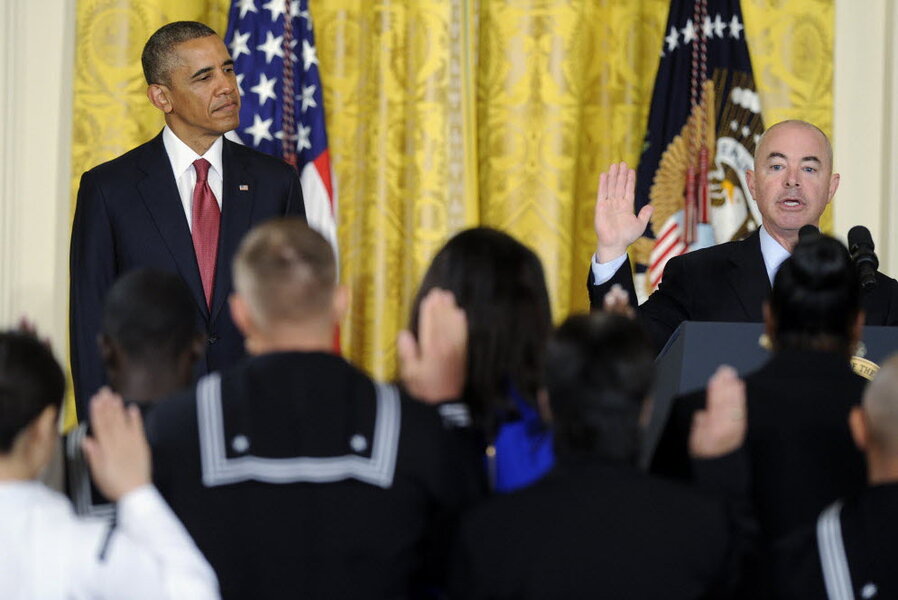On July 4, a pause in immigration rancor to honor new Americans
Loading...
The White House rolled out the red carpet this Fourth of July for 25 immigrants to take the oath of citizenship, hosted by none other than President Obama. But for all its trappings and dignitaries, it is an event that in substance is much like some 100 other naturalization ceremonies across America during the holiday week – a reminder that amid the political turmoil over illegal immigration, the nation still regularly embraces the foreign born into the ranks of the citizenry.
The ceremony at the White House on Friday honors 15 active-duty members of the US military who are legal residents, as well as a reservist, two veterans, and military spouses.
“The basic idea of welcoming immigrants to our shores is central to our way of life, it is in our DNA,” Mr. Obama said at the event. “We believe our diversity, our differences, when joined together by a common set of ideals, makes us stronger, makes us more creative, makes us different.”
Mr. Obama also again characterized the nation’s immigration system as “broken” – and again called upon Congress to pass “common-sense” reform. He promised, too, that “I’ll keep doing everything I can do” to improve it, a veiled reference to his often-repeated warning that he’ll act unilaterally to begin to amend the immigration system, if Congress won’t.
The Senate has approved reform legislation; the House, where the GOP caucus is divided on how to proceed, appears increasingly unlikely to take up the issue this session. Meanwhile, an influx of undocumented women and children stacking up in Texas at the US-Mexico border is stirring grass-roots passions on both sides of the immigration-reform fight, as a humanitarian crisis escalates and immigration enforcement is again questioned.
But the July 4 event at the White House was an occasion to showcase the positive side of immigration and to honor the hundreds of thousands of immigrants who walk the path to US citizenship each year – about 9,000 this week alone.
In Atlanta on Wednesday, 1,094 people became citizens. Sara Szekely was one. Originally from Romania, she celebrated with her children Iza and Truman — “like the president,” she told The Atlanta Journal-Constitution. “It was my time.”
In Bangor, Maine, Abdul Rana, from Pakistan, was among 60 immigrants to swear allegiance to the US during a naturalization ceremony on Thursday. "It's the best thing ever! It feels like a miracle, you know? It's awesome, finally free!" Mr. Rana said to WSCH-TV.
And out in South Dakota, at the Shrine of Democracy at the foot of Mount Rushmore, a former refugee from Sudan expressed his delight at becoming a US citizen. "I am so happy," Ezedeen Mohammed, a meatpacker at a plant in Sioux Falls, said to the Argus Leader – repeatedly. "And so thankful America gave me citizenship and everything for life that is good."
The path to citizenship is not especially easy. On average it takes two years, according to US Citizenship and Immigration Services. Applicants must pass tests, including the ability to speak and write English, and pay a $680 application fee.
About 8 million immigrants are eligible to become US citizens, but for various reasons only about 8 percent of them actually take that step each year, according to The New Americans Campaign, which seeks to help green-card-carrying immigrants move to full citizenship.
One right of citizenship is voting. Naturalized citizens make up about 8 percent of the voting population in the US, research by the Center for the Study of Immigration, at the University of Southern California, found in January 2013. A third of those naturalized voters are Latino, a third are Asian, and the last third are non-Hispanic whites and blacks.
The top countries of origin for naturalized citizens were Mexico, the Philippines, India, Dominican Republic, and China, in that order, in fiscal year 2012, the latest data available.
Within the past 13 years, 2003 saw the fewest new citizens, at 456,063. The most were naturalized in 2008 – almost 1.1 million. The yearly average is about 680,000, government data show.
For the men and women who were sworn in as US citizens at the White House on Friday, the pronouncement “you are now United States citizens” comes with an extra perk: an invitation to a Fourth of July barbecue, concert, and fireworks on the White House South Lawn. Nothing like hanging with Barack and Michelle on your first day as a American.







